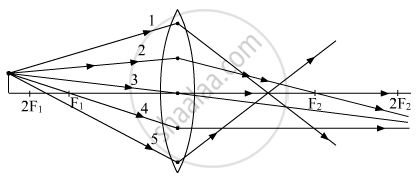Advertisements
Advertisements
प्रश्न
Out of the five incident rays shown in the figure find the three rays that are obeying the laws of refraction and may be used for locating the position of image formed by a convex lens:
(A) 1, 2 and 3
(B) 2, 3 and 4
(C) 3, 4 and 5
(D) 1, 2 and 4
उत्तर
(B)
Rays (2), (3) and (4) obey the laws of refraction.
Ray parallel to the principal axis passes through the second focus of the lens.
Ray passing through the optical center goes undeflected.
Ray passing through the first focus of the lens goes parallel to the principal axis.
APPEARS IN
संबंधित प्रश्न
A 1 cm high object is placed at a distance of 2f from a convex lens. What is the height of the image formed?
Fill in the following blank with suitable word:
The image in a convex lens depends upon the distance of the ........... from the lens.
State whether convex lens has a real focus or a virtual focus.
In order to obtain a real image twice the size of the object with a convex lens of focal length 15 cm, the object distance should be:
(a) more than 5 cm but less than 10 cm
(b) more than 10 cm but less than 15 cm
(c) more than 15 cm but less than 30 cm
(d) more than 30 cm but less than 60 cm
A student did an experiment with a convex lens. He put an object at different distances 25 cm, 30 cm, 40 cm, 60 cm and 120 cm from the lens. In each case he measured the distance of the image from the lens. His results were 100 cm, 24 cm, 60 cm, 30 cm and 40 cm, respectively. Unfortunately his results are written in wrong order.
Which of the object distances gives the biggest image?
What kind of lens can form:
an erect magnified image?
The focal length of a lens is positive. In this case, state the kind of lens.
State two applications of a convex lens.
Can a normal convex lens behave like a concave lens and vice-versa?
Why do we say that the ‘2F’ and ‘F’ points of a convex lens can be regarded as a sort of ‘turning points’ as far as the nature of the image formed by it is concerned?
